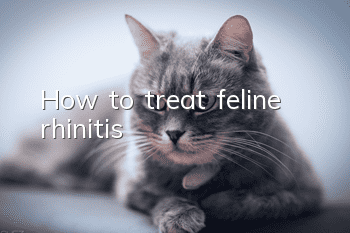How to treat feline rhinitis?

When treating feline rhinitis, you first need to know whether the cat has acute rhinitis or chronic rhinitis, and treat the cat in a warm environment.
Rhinitis is a very common disease, both dogs and cats may have rhinitis. Of course, it is not a big deal if a cat gets rhinitis, but it will be a big deal if it is left alone. Therefore, if a cat gets rhinitis, the owner must treat the cat in time to prevent the cat from suffering from the disease.
1. There are currently several causes of rhinitis in cats
For example, when stimulated by the cold air in winter, the cat's nasal mucosa is prone to congestion and exudation, so the bacteria that are present in the nasal cavity take the opportunity to develop and multiply, causing mucosal inflammation.
For example, when a cat inhales ammonia, chlorine, smoke, dust, pollen, insects, etc., which directly irritates the nasal mucosa, it can also cause nose inflammation.
For example, rhinitis in cats may also be secondary to the spread of certain infectious diseases or inflammation of adjacent organs.
2. Cat rhinitis is mainly divided into acute rhinitis and chronic rhinitis
Chronic rhinitis: The condition develops slowly, with nasal discharge that is more or less frequent and mostly mucopurulent. If inflammation spreads to the paranasal sinuses, it can often cause bone necrosis and tissue disintegration, so the nasal mucus may be mixed with blood and have a putrid smell. Chronic rhinitis can often be the cause of suffocation or encephalopathy and should be taken seriously.
Acute rhinitis: At the beginning of the disease, the nasal mucosa is flushed and swollen, and sneezing occurs frequently. The sick cat often shakes its head or scratches its nose with its front paws, and then the nasal discharge flows from one or both nostrils. It is transparent serous at first, and then It becomes serous, mucinous or mucopurulent, and forms dry scabs around the nostrils after drying. When the condition is severe, the nasal mucosa swells significantly, narrowing the nasal cavity, affecting breathing, and nasal congestion can often be heard. When accompanied by conjunctivitis, the patient may become shy and shed tears. When accompanied by pharyngitis, difficulty swallowing, coughing, and swollen mandibular lymph nodes may occur.
3. Common methods of treating rhinitis in cats
First of all, the cause of the disease should be removed, the sick cat should be placed in a warm environment and given proper rest. Generally speaking, acute mild illnesses can often be cured without medication.
For severe rhinitis, the following drugs can be used to flush the cat’s nasal cavity: 1% saline solution, 2-3% boric acid solution, 1% sodium bicarbonate solution, 0.1% potassium permanganate solution, etc. However, when flushing the nasal cavity, it must be Lower the sick cat's head, rinse it, and instill an anti-inflammatory agent into the nose. In order to promote vasoconstriction and reduce sensitivity, 0.1% epinephrine or phenyl salicylate (Saro) paraffin oil (1:10) can be used for intranasal instillation, or nasal instillation can be used.
- A cat will die if it urinates for a few days
- Should you deworm yourself or go to a pet store?
- Are cat teasers harmful to cats?
- What should I do if my cat suffers from chronic gingivitis?
- Cat's nails are cracked with a thin layer
- Cats go crazy after eating mutton
- What does cat moss on a cat’s chin look like?
- Can cats reproduce after abdominal transmission is cured?
- What exactly is the sterilization shot for female cats?
- Can I still eat unopened cat food if it has expired?



